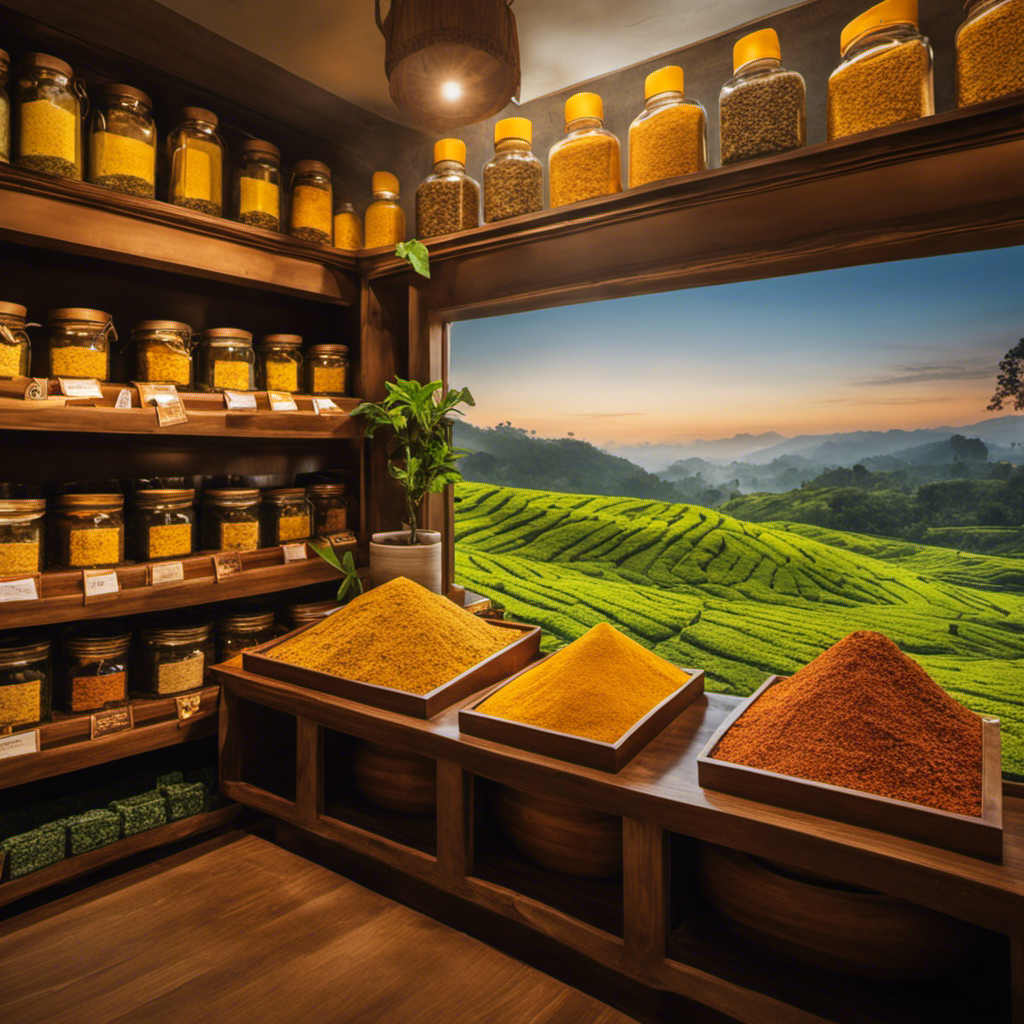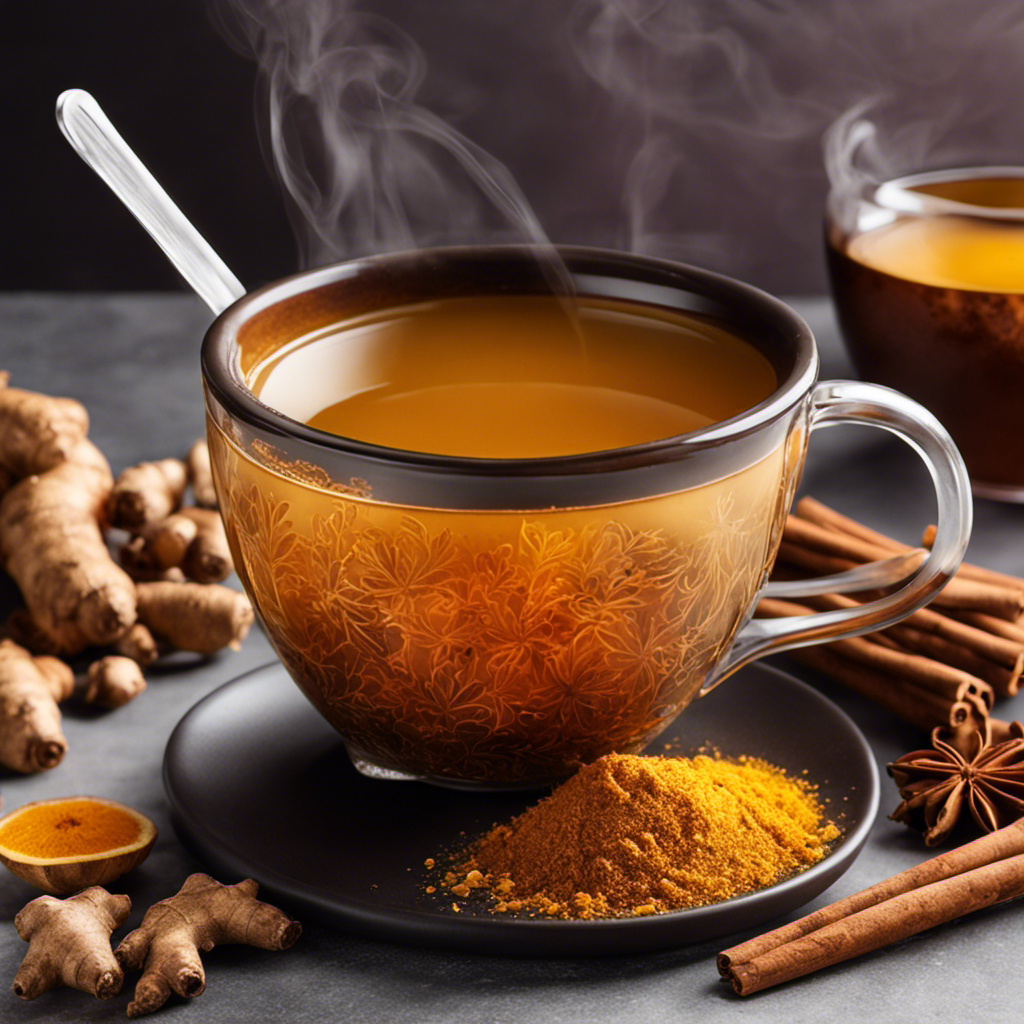Coffee Brewing Methods
The Benefits Of Butter Coffee: A Delightful And Healthier Brew

In a world where coffee has become a staple in many people’s daily routines, a new trend has emerged: butter coffee. This delightful and healthier brew, made with coffee, coconut oil, and ghee/grass-fed butter, offers a unique twist to the traditional cup of joe. The process of making butter coffee is simple, requiring only a coffee maker and a blender.
Not only is it a cost-effective alternative to store-bought coffee, but it also allows individuals to reduce their carbon footprint by using their own mug.
Butter coffee is not just a trend; it comes with a plethora of health benefits. From nourishing the skin to regulating cholesterol levels, this creamy beverage proves to be more than just a tasty treat. It can also decrease inflammation, curb hunger cravings, improve metabolism function, and protect brain neurons. With the option to customize with additional ingredients like cocoa or vanilla, butter coffee provides a satisfying and guilt-free alternative to traditional coffee drinks. Made with real ingredients and without any added sugar, it is a smooth and creamy indulgence that will leave you refreshed and satisfied.
In this article, we will explore the benefits of butter coffee, comparing it to traditional coffee and providing an expert perspective on this delightful and healthier brew. So, grab your mug and prepare to embark on a journey into the world of butter coffee.
Key Takeaways
- Butter coffee is a combination of coffee, coconut oil, and ghee/grass-fed butter, providing numerous health benefits.
- Homemade butter coffee can save money and reduce carbon footprint, making it a cost-effective and environmentally friendly option.
- Butter coffee helps regulate cholesterol levels, decrease inflammation, curb hunger cravings, and improve brain function.
- It can be customized with additional ingredients and is a healthier alternative to traditional coffee drinks.
What is it?
Butter coffee, also known as bulletproof coffee, is a combination of coffee, coconut oil, and ghee/grass-fed butter, made with a simple coffee maker and a blender, resulting in a smooth, creamy, and rich beverage.
Different variations of butter coffee exist, with some recipes including additional ingredients like cocoa, peppermint extract, or vanilla to personalize the taste.
One of the potential benefits of butter coffee is its association with weight loss. The inclusion of healthy fats from grass-fed butter and coconut oil can help curb hunger cravings and make fasting easier. Additionally, the medium-chain triglycerides (MCTs) present in coconut oil have been shown to improve metabolism function.
However, it is important to note that while butter coffee may have potential benefits, it is not a magical solution for weight loss and should be consumed as part of a balanced diet and healthy lifestyle.
How it’s Made
Blending a combination of ingredients such as coffee, coconut oil, and ghee/grass-fed butter is essential to create a well-emulsified and satisfying beverage.
To make butter coffee, start by brewing a fresh cup of coffee using a simple coffee maker.
Next, add a tablespoon of coconut oil and a tablespoon of ghee or grass-fed butter to a blender.
Pour the hot coffee into the blender and blend on high for about 20-30 seconds until a creamy foam forms on top. Blending is important to emulsify the fats and prevent separation. However, it is crucial to avoid adding too much coconut oil, as it can lead to an upset stomach.
Using quality butter, like Kerrygold, is recommended for the best taste and health benefits.
By following these steps, you can enjoy a smooth, creamy, and satisfying cup of butter coffee.
When making butter coffee, there are a few common mistakes to avoid.
Firstly, using low-quality or salted butter can negatively impact the taste and texture of the drink. It is important to opt for unsalted grass-fed butter to ensure a rich and flavorful result.
Additionally, adding too much butter or coconut oil can lead to an overly greasy beverage that may be difficult to digest. It is recommended to start with smaller amounts and adjust according to personal preference.
Lastly, blending the ingredients thoroughly is crucial for achieving a creamy and well-mixed coffee. Neglecting this step may result in separation of the fats and an uneven taste.
Taking these considerations into account will help you create a delicious and satisfying cup of butter coffee.
Health Benefits
Consuming a combination of coffee, coconut oil, and ghee/grass-fed butter has been associated with potential positive effects on cholesterol levels, inflammation, hunger cravings, blood sugar levels, brain function, and metabolism.
-
Nourishes the skin, providing building blocks for healthy hormones, resulting in a radiant complexion.
-
Curbs hunger cravings, making it easier to adhere to a balanced and healthy diet.
-
Helps regulate cholesterol levels, decreasing the risk of heart disease and promoting cardiovascular health.
-
Maintains stable blood sugar levels, reducing cravings for sugary foods and supporting weight management.
-
The medium-chain triglycerides (MCTs) in coconut oil improve metabolism function and aid in fat burning.
By incorporating butter coffee into your daily routine, you can experience these benefits while enjoying a smooth, creamy, and satisfying beverage. It provides a healthier alternative to traditional coffee drinks, which often contain artificial ingredients and high amounts of sugar.
Additionally, homemade butter coffee is a cost-effective option compared to coffee shop purchases.
Start your day with a delightful and nourishing brew that supports your overall well-being.
Comparison to Traditional Coffee
When comparing butter coffee to traditional coffee drinks, it is evident that the former offers a more nourishing and wholesome option that supports overall well-being. Butter coffee is made with real ingredients, such as grass-fed butter and coconut oil, and contains no sugar or artificial additives. On the other hand, traditional coffee drinks, like the popular Pumpkin Spice Latte, often contain excessive amounts of sugar and artificial ingredients, which can have negative effects on health. To further highlight the advantages of butter coffee, a comparison table is provided below:
| Butter Coffee | Traditional Coffee Drinks |
|---|---|
| Made with real ingredients | Contain artificial ingredients |
| Nourishing and wholesome | High amounts of sugar |
| Supports overall well-being | Potential negative health effects |
Opting for butter coffee over traditional coffee drinks can provide a delightful and healthier brew that satisfies both taste buds and promotes wellness.
Expert Perspective
The expert perspective on butter coffee highlights its potential as a more nourishing and wholesome alternative to traditional coffee drinks.
The importance of quality ingredients in butter coffee cannot be stressed enough. Using high-quality butter, like Kerrygold, ensures that you are getting the best possible flavor and health benefits. Additionally, using organic coffee beans and coconut oil can further enhance the nutritional value of the drink.
However, it is important to be mindful of the potential side effects of consuming too much coconut oil in butter coffee. Adding excessive amounts of coconut oil can lead to an upset stomach and digestive issues. It is recommended to start with a small amount and gradually increase it to avoid any discomfort.
As with any dietary change, it is always advisable to consult with a healthcare professional before incorporating butter coffee into your daily routine.
Frequently Asked Questions
Can I use any type of coffee beans to make butter coffee?
Different coffee flavors can be used to make butter coffee, as the choice of coffee beans can affect the overall taste. However, it is important to note that the benefits of using grass-fed butter in butter coffee remain the same regardless of the coffee flavor.
Grass-fed butter is preferred due to its higher nutrient content, including essential fatty acids and fat-soluble vitamins. It also provides a rich and creamy texture to the coffee, enhancing the overall flavor and satisfaction.
Is it necessary to use a blender to make butter coffee, or can I just stir the ingredients together?
To achieve the creamiest butter coffee, blending the ingredients is necessary. Stirring alone may not effectively emulsify the fats and could result in separation. Blending creates a smooth and rich texture, ensuring that the coffee, coconut oil, and butter are thoroughly combined.
The impact of using different types of butter on the taste and texture of butter coffee can vary. Quality butter, such as Kerrygold, is recommended for its superior taste. Experimenting with various types of butter can help personalize the flavor profile of the coffee.
Can I add sugar or sweeteners to my butter coffee?
Adding sweeteners to butter coffee can be a matter of personal preference. However, it is important to note that the original recipe for butter coffee does not include sugar or sweeteners. The combination of coffee, coconut oil, and ghee/grass-fed butter already provides a smooth, creamy, and rich flavor. Adding sugar or sweeteners may alter the taste and potentially overpower the delicate flavors of the coffee and fats. Additionally, the type of coffee beans used can also impact the flavor of butter coffee, with different beans offering unique profiles that can enhance or change the overall taste experience.
Can I use margarine or other types of butter substitutes instead of grass-fed butter?
When it comes to making butter coffee, it is recommended to use grass-fed butter instead of margarine or other butter substitutes.
Grass-fed butter is a healthier option as it is higher in nutrients and contains a better balance of omega-3 and omega-6 fatty acids.
Margarine, on the other hand, is often highly processed and may contain unhealthy trans fats.
Using grass-fed butter in butter coffee provides the benefits of nourishing the skin, regulating cholesterol levels, decreasing inflammation, and improving brain function, among others.
Can I drink butter coffee if I am lactose intolerant?
For those who are lactose intolerant, there are alternatives available to enjoy the health benefits of butter coffee. While traditional butter contains lactose, ghee is a lactose-free option that can be used instead. Ghee is clarified butter that has had the lactose and milk solids removed.
It still provides the same richness and flavor as butter, making it a suitable substitute. Ghee also offers many of the same health benefits as butter, such as nourishing the skin, regulating cholesterol levels, and decreasing inflammation.
Conclusion
In conclusion, butter coffee offers a delightful and healthier alternative to traditional coffee drinks.
This homemade beverage not only provides a delicate and delightful foam at the top but also offers numerous health benefits, such as nourishing the skin, regulating cholesterol levels, and curbing hunger cravings.
Additionally, it can help maintain stable blood sugar levels, protect brain neurons, and provide cognitive benefits.
While some may argue that butter coffee is high in saturated fat, it is important to note that it can be consumed in moderation as part of a balanced diet.
With its customizable options and real ingredients, butter coffee is a smooth, creamy, and satisfying brew worth considering.
Noah, the Editor-in-Chief at Cappuccino Oracle, plays a pivotal role in shaping the voice and vision of our renowned platform. With an unwavering passion for coffee, coffee alternatives, and tea, Noah leads Cappuccino Oracle towards new horizons in the realm of coffee journalism.
Beyond his professional responsibilities, Noah serves as a mentor and guiding force for his team. His dedication to journalistic excellence and genuine love for coffee, coffee alternatives, and tea continue to inspire and motivate the Cappuccino Oracle family. In the ever-evolving world of these beverages, Noah’s leadership ensures that our platform remains at the forefront, delivering enlightening and enjoyable content to our readers worldwide.
Coffee Brewing Methods
What Is Coffee Powder? A Guide To Instant Coffee And Its Benefits

Instant coffee, also referred to as coffee powder, offers a quick and convenient solution for coffee lovers to savor their preferred drink. Its ease of preparation has made it a household essential for numerous coffee aficionados.
But what exactly is coffee powder and how is it made?
Coffee powder is made by roasting coffee beans, grinding them, brewing the coffee, and then removing the water to create a dissolvable powder. This process ensures that all the flavors and aromas of the coffee beans are captured in the powder, allowing for a rich and flavorful cup of coffee.

One interesting statistic to note is that coffee powder and ground coffee are not the same. Instant coffee has already undergone the entire coffee-making process, making it different from ground coffee.
In addition to its convenience, coffee powder also provides the same nutrients as a standard cup of coffee. However, it is important to consume it in moderation as it contains caffeine. Reading nutrition labels and checking caffeine quantities is essential to avoid unintentional overdosing.
In this article, we will delve deeper into the world of coffee powder, exploring its production process, caffeine content, and safety considerations. So grab a cup of coffee, sit back, and let’s explore the wonders of coffee powder together.
Key Takeaways
- Coffee powder, also known as instant coffee, is a convenient way to enjoy coffee.
- It is important to consume coffee powder in moderation due to its caffeine content.
- Coffee powder provides the same nutrients as a standard cup of coffee.
- Coffee powder production has environmental impacts, but efforts are being made to reduce them through sustainable practices and technologies.
What is it?
Coffee powder, also known as instant coffee, is a soluble form of coffee made by roasting, grinding, brewing, and dehydrating coffee beans. This process results in a dissolvable powder that can be consumed as a beverage or used in cooking.
There are different types of coffee powders available, with varying flavors and strengths to suit individual preferences. One of the main advantages of coffee powder is its convenience and ease of use. It can be quickly dissolved in hot water, eliminating the need for brewing equipment or waiting for a pot of coffee to brew.
Additionally, coffee powder offers several health benefits. It contains antioxidants that help protect cells from damage, and it has been associated with a reduced risk of various diseases, including type 2 diabetes, Parkinson’s disease, and liver cancer. However, it is important to consume coffee powder in moderation, as it can also have negative effects on sleep, anxiety, and digestive health.
How it’s Made
To produce coffee powder, coffee beans are first roasted, then ground, brewed, and finally dehydrated through either spray-drying or freeze-drying methods.
-
Spray-drying involves spraying a liquid coffee extract into a hot chamber, where the water evaporates, leaving behind dried coffee particles.
-
Freeze-drying, on the other hand, involves freezing the brewed coffee and then placing it in a vacuum chamber. The frozen water in the coffee sublimates, turning directly into vapor and leaving behind freeze-dried coffee particles.
Pros and cons of these manufacturing methods include:
-
Spray-drying is a faster and more cost-effective process, but it can result in a loss of flavor and aroma due to the high heat involved.
-
Freeze-drying preserves the flavor and aroma better, but it is a slower and more expensive process.
The environmental impact of coffee powder production includes energy consumption, water usage, and waste generation from the manufacturing processes. Efforts are being made to reduce these impacts through sustainable practices and technologies.
Caffeine Content and Safety
The caffeine content in coffee powder should be taken into consideration to ensure safe consumption. Different coffee brands may vary in their caffeine content, and it is important to be aware of the levels present in the product.
Consuming excessive amounts of caffeine can have various health effects. While caffeine can provide temporary alertness and improved cognitive function, excessive consumption can lead to negative side effects such as restlessness, insomnia, increased heart rate, and even anxiety. It is essential to be mindful of one’s caffeine intake, as exceeding the recommended daily limit can have adverse effects on health.
Therefore, it is advisable to check the caffeine quantities mentioned on the packaging of coffee powder and other coffee-related products to avoid unintentional overdosing. Moderation is key when it comes to consuming caffeine-rich beverages.
Frequently Asked Questions
How long does coffee powder last after it has been opened?
The shelf life of opened coffee powder depends on several factors, including storage conditions and the type of packaging. Generally, coffee powder can last for several months to a year after it has been opened.
To extend its shelf life, it is important to store it in an airtight container in a cool, dark place away from moisture and heat. Following these storage tips can help maintain the flavor and freshness of the coffee powder for a longer period of time.
Can coffee powder be used to make espresso?
Coffee powder can be used as an alternative to espresso, but it may not provide the same depth and intensity of flavor. When choosing a coffee powder for espresso, it is important to consider the roast level and grind size. Darker roasts and finer grinds tend to produce a more espresso-like flavor. However, it is important to note that instant coffee may not be able to replicate the crema and richness that is characteristic of a true espresso shot.
Is coffee powder suitable for people with acid reflux or sensitive stomachs?
For individuals with acid reflux or sensitive stomachs, coffee powder may not be the best option. However, there are coffee powder alternatives that are considered to be more suitable.
One interesting statistic is that low acid coffee, such as those made from beans processed with the Swiss Water Method, can have up to 70% less acid compared to regular coffee.
These alternatives provide a milder and less irritating option for individuals with acid reflux or sensitive stomachs.
Can coffee powder be used in baking recipes?
Coffee powder can indeed be used in baking recipes to add a rich coffee flavor to desserts. It is important to note that coffee powder is different from instant coffee. Instant coffee is already brewed and dehydrated, while coffee powder is simply the powdered form of ground coffee beans.
When using coffee powder in baking, it can be dissolved in a small amount of hot water before adding it to the recipe. This will ensure that the coffee flavor is evenly distributed throughout the dessert.
So, coffee powder can be a great addition to various desserts, such as cakes, cookies, and brownies, to enhance their taste with a hint of coffee.
Does coffee powder have the same antioxidant benefits as freshly brewed coffee?
Coffee powder, also known as instant coffee, contains a similar antioxidant content as freshly brewed coffee. Antioxidants are compounds that help protect against oxidative stress and reduce the risk of chronic diseases.
Instant coffee is made from roasted coffee beans, ground, brewed, and then dehydrated to form a powder. While the drying process may slightly reduce the antioxidant levels compared to freshly brewed coffee, instant coffee still provides health benefits associated with antioxidants.
Conclusion
In conclusion, coffee powder, also known as instant coffee, is a convenient and popular option for coffee lovers. It is made through a process of roasting, grinding, brewing, and drying coffee beans.
This dissolvable powder offers the same nutrients as a standard cup of coffee and can be consumed by dissolving it in hot water or incorporating it into recipes. However, it is crucial to be mindful of the caffeine content and consume it in moderation.
An interesting statistic to note is that coffee is the second most traded commodity in the world, after oil, highlighting its global popularity and significance.
Noah, the Editor-in-Chief at Cappuccino Oracle, plays a pivotal role in shaping the voice and vision of our renowned platform. With an unwavering passion for coffee, coffee alternatives, and tea, Noah leads Cappuccino Oracle towards new horizons in the realm of coffee journalism.
Beyond his professional responsibilities, Noah serves as a mentor and guiding force for his team. His dedication to journalistic excellence and genuine love for coffee, coffee alternatives, and tea continue to inspire and motivate the Cappuccino Oracle family. In the ever-evolving world of these beverages, Noah’s leadership ensures that our platform remains at the forefront, delivering enlightening and enjoyable content to our readers worldwide.
Coffee Brewing Methods
The Art Of Cold Brew: Mastering The Perfect Ratio

Cold brew coffee has gained immense popularity for its velvety flavor and invigorating effects. It is essential to attain the ideal balance of coffee and water for achieving the desired taste.
The general consensus for cold brew is a 1:5 ratio, but experimentation is encouraged to find the preferred taste. Properly soaking coarsely ground coffee beans is essential for extracting the flavors.
It is advisable to only make what will be consumed to avoid waste, as cold brew can last up to a week in the refrigerator. Surprisingly, cold brew can be stronger than hot coffee, depending on the ratio used. Dilution with water or ice is unnecessary, as it is already factored into the drink.
Personal preference plays a significant role in determining the strength of cold brew, and the taste can be adjusted through dilution or mixing with other ingredients such as sweetened milk or liquid sugar.
With the knowledge of cold brew ratios, one can craft the perfect cup of cold brew and customize its strength according to their liking.
Key Takeaways
- The proportion of coffee to water is crucial in making cold brew.
- The general consensus for cold brew is a 1:5 proportion of coffee to water.
- Experimentation with ratios is encouraged to find the preferred taste.
- Properly soaking the coarsely ground coffee beans is important.
What is Cold Brew?
Cold brew is a method of coffee extraction that involves steeping coarsely ground coffee beans in cold water for an extended period of time, resulting in a smooth, low-acid coffee concentrate.
Unlike iced coffee, which is brewed with hot water and then cooled down, cold brew is made by using only cold water throughout the entire brewing process.
This slow extraction method enhances the flavor profile of the coffee, resulting in a beverage that is less bitter and acidic compared to traditional brewing methods.
Additionally, cold brew offers health benefits such as reduced acidity, which can be beneficial for individuals with sensitive stomachs.
The lower acidity also makes cold brew a more teeth-friendly option, as it is less likely to cause enamel erosion.
Ratio Importance
The key to achieving the ideal taste in cold brew lies in finding the precise balance between the amount of coffee and water used, as this proportion directly impacts the flavor profile and strength of the final product, analogous to the delicate interplay of notes in a symphony.
Exploring different ratios allows for customization and experimentation, enabling cold brew enthusiasts to find the perfect balance that suits their taste preferences. While the general consensus for cold brew is a 1:5 ratio of coffee to water, personal preference plays a significant role in determining the preferred strength.
Dilution with additional water or ice is not necessary, as it is already factored into the drink. It is essential to properly soak the coarsely ground coffee beans to extract the desired flavors and avoid any bitterness.
By mastering the art of finding the perfect ratio, one can craft a cold brew that is both smooth and invigorating.
Tips for Brewing
To achieve optimal results when brewing cold brew coffee, it is beneficial to follow a few helpful tips.
Firstly, ensure that you are using the correct coffee to water ratio. The general consensus for cold brew is a 1:5 proportion of coffee to water, but feel free to adjust this ratio to suit your personal taste preferences.
Additionally, choose high-quality, freshly-ground coffee beans for maximum flavor extraction. Coarsely ground beans work best for cold brew, as they allow for a slower extraction process.
When soaking the coffee grounds, make sure they are fully submerged in water and stir gently to ensure even saturation.
Steep the mixture in the refrigerator for at least 12 hours, or up to 24 hours for a stronger brew.
Finally, strain the mixture through a fine mesh sieve or a coffee filter to remove any sediment.
By following these tips, you can maximize the flavor and enjoyment of your cold brew coffee.
Frequently Asked Questions
Can I use any type of coffee to make cold brew, or are there specific types that work better?
While any type of coffee can be used to make cold brew, certain coffee bean varieties work better due to their flavor profiles. Different coffee bean varieties can result in varying taste profiles, acidity levels, and strength in cold brew.
Some popular choices for cold brew include medium to dark roast beans, which tend to have a richer and bolder flavor. Additionally, brewing methods such as immersion or slow drip can also impact the taste and strength of the cold brew.
How long should I steep the coffee beans in water to achieve the desired strength of cold brew?
The steeping time for cold brew and the best coffee beans to use are important factors in achieving the desired strength of cold brew.
The duration of steeping the coffee beans in water varies depending on personal preference. Generally, a steeping time of 12-24 hours is recommended for a strong and flavorful cold brew. However, some individuals prefer a longer steeping time of up to 48 hours for a bolder taste.
It is important to choose coffee beans specifically labeled for cold brew as they are coarsely ground and have the ideal flavor profile for this brewing method.
Can I make cold brew in larger batches and store it for longer than a week in the refrigerator?
In the realm of cold brew coffee, the quest for the perfect ratio is akin to an artist striving for their masterpiece.
When it comes to storing larger batches of cold brew for an extended period in the refrigerator, caution must be exercised.
While cold brew can be made in larger quantities, it is recommended to consume it within a week for optimal freshness. Prolonged refrigeration may result in a decline in taste and quality.
Therefore, it is best to craft smaller batches to savor the true essence of cold brew.
Is it necessary to use coarsely ground coffee beans for cold brew, or can I use a different grind size?
Different grind sizes for cold brew can affect the quality and taste of the final product. While it is not necessary to use coarsely ground coffee beans for cold brew, it is highly recommended. Coarsely ground coffee allows for a slower extraction process, resulting in a smoother and less bitter brew.
Finely ground coffee can lead to over-extraction and a more acidic taste. Therefore, using coarsely ground coffee beans provides the benefits of a better flavor profile and a more enjoyable cold brew experience.
Can I use hot water instead of cold water to make cold brew, or will it affect the taste?
Using hot water for cold brew: pros and cons
The temperature of the water significantly affects the extraction process and flavor of cold brew.
Using hot water for cold brew has both pros and cons. Hot water can extract flavors more quickly, resulting in a shorter brewing time. However, it can also lead to over-extraction, resulting in a bitter taste.
Cold water, on the other hand, allows for a slower extraction process, resulting in a smoother and less acidic flavor.
Therefore, using hot water for cold brew can alter the taste and may not achieve the desired flavor profile.
Noah, the Editor-in-Chief at Cappuccino Oracle, plays a pivotal role in shaping the voice and vision of our renowned platform. With an unwavering passion for coffee, coffee alternatives, and tea, Noah leads Cappuccino Oracle towards new horizons in the realm of coffee journalism.
Beyond his professional responsibilities, Noah serves as a mentor and guiding force for his team. His dedication to journalistic excellence and genuine love for coffee, coffee alternatives, and tea continue to inspire and motivate the Cappuccino Oracle family. In the ever-evolving world of these beverages, Noah’s leadership ensures that our platform remains at the forefront, delivering enlightening and enjoyable content to our readers worldwide.
Coffee Brewing Methods
The Art Of Brewing Perfect Espresso At Home

In the quest for the ultimate espresso, there exists an artistic skill that goes beyond the routine task of preparing coffee. It is a careful procedure that requires constant focus on every detail, a steadfast dedication to maintaining consistency, and an unbreakable passion for the trade.
Brewing the perfect espresso at home is not for the faint of heart; it requires a deep understanding of the essential steps, the right techniques, and the precise measurements. Like a virtuoso composing a symphony, the home barista must master the delicate dance of grinding and tamping, the intricate art of milk steaming, and the artful balance of flavors.
With each sip, a harmonious symphony of taste unfolds, awakening the senses and transporting the drinker to a realm of pure bliss. Join us on this journey as we unlock the secrets of the art of brewing perfect espresso at home, and embark on a quest to elevate your coffee experience to new heights.
Key Takeaways
- Pursuit of perfect espresso requires art, attention to detail, consistency, and dedication.
- Brewing perfect espresso at home requires understanding essential steps, techniques, and measurements.
- Home baristas must master grinding, tamping, milk steaming, and flavor balance.
- The key to brewing a perfect espresso lies in the harmonious symphony of taste achieved through essential steps such as setting the grinder, using the right amount of ground coffee, tamping evenly, timing the shot, and adjusting based on taste indicators.
Essential Steps
The essential steps in brewing perfect espresso at home include:
- Setting the grinder to a fine grind size
- Using around 20 grams of ground coffee in the portafilter
- Evenly and firmly tamping the grounds
- Timing the shot to hit 60 ml in 20-30 seconds
- Adjusting the grind size and extraction based on taste indicators such as sourness or bitterness
Preheating equipment, such as the espresso maker, is also crucial to ensure consistent results. Additionally, the dialing in process, which involves adjusting the grind size and extraction time, may need to be repeated when switching between different coffee roasts.
By following these steps and techniques, coffee enthusiasts can achieve the perfect balance of flavors and aromas in their homemade espresso.
Grinding and Tamping
Grinding and tamping are essential steps in the espresso-making process. The grind size selection plays a crucial role in determining the quality of the extraction. A fine grind size is typically preferred for espresso, as it allows for a slower extraction and enhances the flavors. However, finding the perfect grind size may require some experimentation and adjustments to achieve the desired taste profile.
Tamping, on the other hand, involves evenly pressing the ground coffee in the portafilter with the right amount of pressure. This step ensures that water passes through the coffee evenly during extraction, avoiding channeling and promoting consistent extraction. Tamping straight and level is important to prevent any inconsistencies in the extraction process.
By mastering the art of grinding and tamping, one can achieve a superior espresso shot with optimal flavor and aroma.
Milk Steaming Techniques
Milk steaming techniques play a crucial role in achieving the desired consistency and temperature for milk-based espresso drinks.
The temperature of the milk is a key factor in creating a creamy and velvety texture, while the frothing techniques determine the amount and quality of foam.
A common technique is to position the steam wand just below the surface of the milk, creating a whirlpool effect to incorporate air and create microfoam.
The aim is to achieve a temperature of around 150°F (65°C) and a smooth, glossy texture.
It is important to practice and experiment with different techniques to find the perfect balance between heating the milk and creating the desired amount of foam.
With consistent practice and attention to detail, mastering milk steaming techniques will enhance the overall espresso experience.
Frequently Asked Questions
What is the ideal water temperature for brewing espresso at home?
The ideal water temperature for brewing espresso at home is between 195°F and 205°F (90°C and 96°C). This temperature range is crucial in extracting the flavors and aromas from the coffee beans.
Additionally, it ensures that the espresso shot is not under-extracted or over-extracted, resulting in a balanced and flavorful cup of coffee.
Using freshly roasted coffee beans is also essential as they possess more volatile compounds that contribute to the rich and complex flavors in the espresso shot.
Can I use pre-ground coffee for brewing espresso?
Using pre-ground coffee for brewing espresso can be done, but it may not produce the best results. The key to achieving a high-quality espresso lies in the freshness of the coffee grounds. Pre-ground coffee tends to lose its flavor and aroma over time, resulting in a less satisfying espresso.
To truly experience the nuances and complexity of espresso, it is recommended to invest in a good espresso machine and follow a step-by-step espresso brewing guide. This will ensure that you have control over the grind size, dosage, and extraction time, allowing you to achieve the perfect espresso shot.
How often should I clean my espresso machine?
Regularly cleaning and descaling your espresso machine is of utmost importance. Neglecting this essential task will result in subpar espresso and potential damage to your machine.
To maintain optimal performance, deep clean your espresso machine at least once a month. Use a mixture of water and vinegar or a commercial descaling solution to remove mineral buildup.
Additionally, regularly clean removable parts such as the portafilter, steam wand, and drip tray to prevent the buildup of coffee residue and ensure a consistently delicious brew.
What is the recommended ratio of coffee to water for brewing espresso?
The recommended ratio of coffee to water for brewing espresso is around 20 grams of ground coffee to produce 60 ml of espresso shot within 20-30 seconds.
To achieve the perfect extraction time, it is crucial to set the grinder to a fine grind size and tamp the grounds evenly and with pressure. This ensures consistent extraction and avoids under or over-extraction.
Adjusting the grind size may be necessary to fine-tune the extraction process.
Are there any alternative milk options for steaming and frothing?
Alternative milk options for steaming and frothing can be used to achieve the perfect microfoam for latte art.
Non-dairy milk options such as almond milk, soy milk, oat milk, and coconut milk offer alternatives for those who are lactose intolerant or prefer plant-based options.
These alternatives can produce a creamy and frothy texture similar to dairy milk when steamed properly.
Experimenting with different milk options and techniques is crucial to achieving the desired results in latte art with non-dairy milk.
Noah, the Editor-in-Chief at Cappuccino Oracle, plays a pivotal role in shaping the voice and vision of our renowned platform. With an unwavering passion for coffee, coffee alternatives, and tea, Noah leads Cappuccino Oracle towards new horizons in the realm of coffee journalism.
Beyond his professional responsibilities, Noah serves as a mentor and guiding force for his team. His dedication to journalistic excellence and genuine love for coffee, coffee alternatives, and tea continue to inspire and motivate the Cappuccino Oracle family. In the ever-evolving world of these beverages, Noah’s leadership ensures that our platform remains at the forefront, delivering enlightening and enjoyable content to our readers worldwide.
-

 Mushroom Coffee3 weeks ago
Mushroom Coffee3 weeks agoYour Ultimate Guide to Ryze Mushroom Coffee: 9 Things to Know
-

 Mushroom Coffee3 weeks ago
Mushroom Coffee3 weeks agoUnveiling the Puzzle: Top 10 Alternatives to Ryze Mushroom Coffee Revealed
-

 Mushroom Coffee3 weeks ago
Mushroom Coffee3 weeks agoUnveiling the Mysteries of Ryze Mushroom Coffee: Top 10 Questions Answered
-

 Rooibos2 weeks ago
Rooibos2 weeks ago9 Essential Steps to Perfect Rooibos Tea: A Brewing Guide
-

 Mushroom Coffee3 weeks ago
Mushroom Coffee3 weeks ago3 Best Techniques to Brew Ryze Mushroom Coffee
-

 Coffee Basics3 weeks ago
Coffee Basics3 weeks agoHow Do Starbucks’ Seasonal Specialties Appeal to Customers?
-

 Turmeric Tea2 weeks ago
Turmeric Tea2 weeks agoTurmeric Ginger, Cinnamon, Lemon, Honey Tea Benefits
-

 Mushroom Coffee3 weeks ago
Mushroom Coffee3 weeks agoIs Ryze Mushroom Coffee’s Caffeine Content More like Decaf or Regular Coffee?
















